How many famous Spanish fruits do you know? Fruits play an essential role in Spanish cuisine. They appear in many fantastic recipes and are popular choices of Spanish people for dessert.
It is time to enter the world of popular fruits in Spain. The article will provide important information you need to know about these fruits. Therefore, focus on reading this post to receive helpful knowledge.
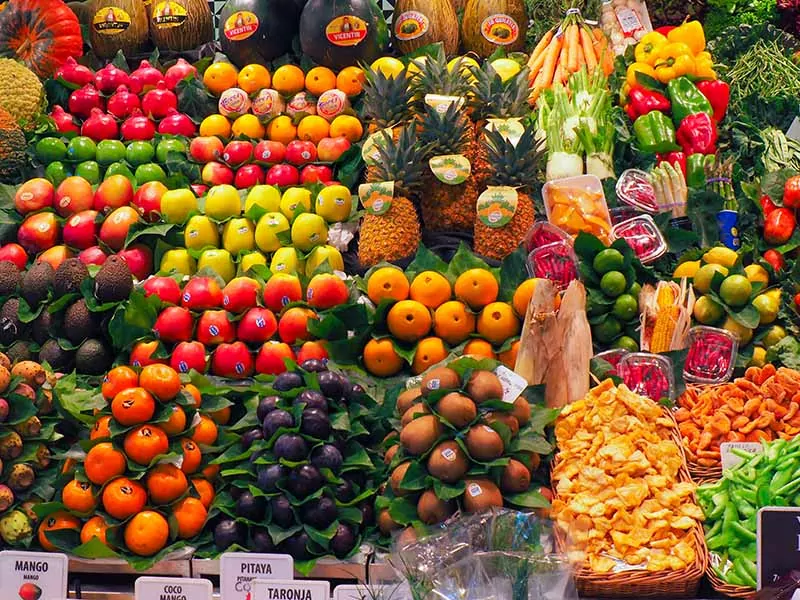
Famous Spanish Fruits Belong To Berry Category
First, I will introduce popular Spanish fruits of the berry category. You will easily come across them in meals, recipes, and menus of restaurants in Spain.
1. Persimmon – Kaki
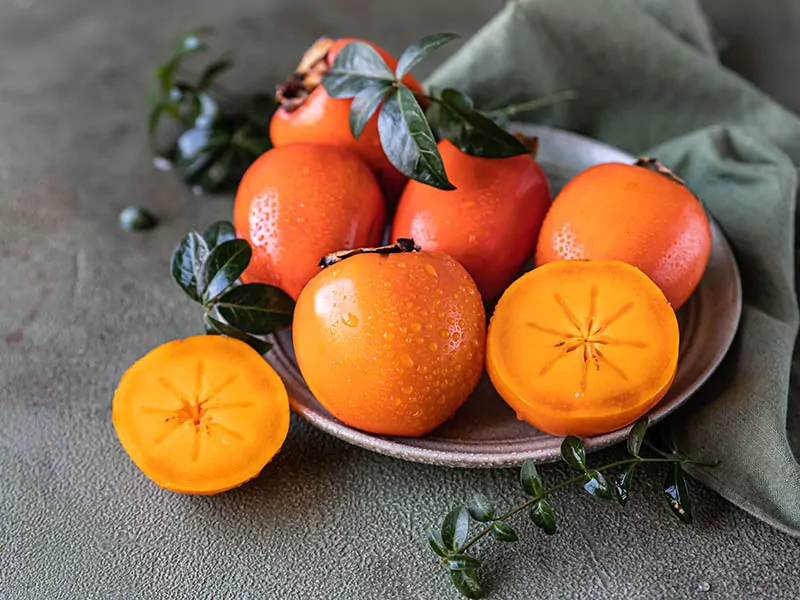
Besides yummy Spanish foods, you can make your trip memorable with outstanding Persimmon (Kaki). This raw fruit has yellow-orange, and it will get dark red-orange when ripe. Spanish persimmon will be lack of seeds and bitterness when people pick it before it is ripe.
You will have the opportunity to see yellow, orange, or dark-brown hues of its flesh when it is ripe. It contains significant sucrose, fructose, and glucose content, so the sweetness is its distinctive flavor.
In addition, a bit of sourness will make it more attractive. This fruit is beneficial for your immune system. It was grown in China in the 8th century and appeared in Europe and Spain in the 19th century. It is a popular fruit in Valencia, Spain.
Nutrients: Rich fiber, dietary minerals, provitamin A beta-carotene, vitamin C, iron, and catechin.
Season: The primary season lasts from mid-October to January.
How to eat: To enjoy it, you just need to peel, cut the two heads and consume like you eat apples. You can eat it raw or prepare smoothies and fruit desserts with it.
Let’s taste persimmon in Spain in November right now.
2. Avocado – Aguacate

Aguacate or Spanish Avocado is a favorite fruit in Spain. Avocados originated from the Tehuacan Valley of Mexico, and gradually avocado cultivation takes place in many regions worldwide. It is a popular subtropical fruit.
You will love buttery flesh when you enjoy ripe avocado. It has various colors like green, black, brown, or purplish. It is shaped like pears or eggs. People often remove its large seed when eating.
Aguacate is the source of the English name “Avocado”. Spain has two local types of Aguacate. Haas avocado has thick skin and is common from November to January, while the remaining type has a thinner skin and appears all year round.
In Spain, Granada is the area with the highest produced avocado every year with about 20 million kilos. The gentle, earthy, and nutty flavor will be suitable for salads and smoothies. Aguacate contains a lot of fats (15%), protein, vitamins, and minerals.
Nutrients: Rich in fat, protein, calories, vitamin K, E, C, and potassium.
Season: It starts to grow from December to May in Spain.
How to eat: Choose ripe avocados and remove the skin and a large seed in the middle. Take a spoon to get the flesh to eat.
3. Pomegranate – Granada

Granada or Pomegranate (English name) is a favorite fruit in Spain. Its name is derived from the word “Pomum,” which means “apples,” and “granatum,” which means “seeds” in Latin. It is made up of Ovary of flowers with various colors like yellow and red.
This fruit was native to the Mediterranean region in ancient times. It appeared in Spain at the end of the 16th century, and Spaniards brought it to California and American countries in 1769.
Its season usually starts from October to February in the North Hemisphere, while it is widespread from March to May in the South Hemisphere. It has a round shape with thick skin. There are countless edible seeds (about 200 to 1400 seeds) inside this shell.
When ripe, these seeds will turn red and full of sweetness and tanginess. Spaniards often make cocktails, smoothies, alcohol, or garnish with this fruit. Nowadays, it is famous all over the world. You should opt for red versions because they are sweeter than yellow ones.
Nutrients: It consists of water, carbohydrates, protein, fat, vitamin C, K, and fiber.
Season: Its season lasts until the end of October and November in Spain.
How to eat: Cut around Pomegranate and soak it in water to make seeds lose. Use your hands to separate the fruit into individual parts and collect its seeds.
Take a trip to Spain to discover some exciting things about Pomegranate.
4. Blueberries – Arandanos

There are many amazing Spanish recipes prepared from blueberries or Arandanos. It originates in North America and is now widespread in Europe, Asia, and many other parts. In Spain, it is well-known in Cantabrian coastal areas.
In Spain, the demand for blueberries is increasing, so its cultivation has become popular. Huelva province produces the most blueberries in Spain since it is less affected by frost and has a suitable temperature for its development.
Blueberries are formed through cross-pollination. It is small in size, with about 5 to 16 millimeters. Raw blueberry has light green and will turn to blue when ripe. It has an epicuticular wax (bloom) layer to protect the skin.
Typically, it will have a sweet taste. However, some variants will have an acidic flavor. In the Northern Hemisphere, its season is usually from May to August. Blueberry appears in many smoothies, jams, jellies, muffins, and other desserts.
Nutrients: It includes protein, carbohydrates, fat, vitamin K, C, fiber, and many minerals.
Seasons: The season will kick off in March and finish in June.
How to eat: You can eat raw blueberry or combine it in smoothies, salads, jams, and many desserts.
5. Blackberries – Moras

It is impossible not to mention blackberries when it comes to famous Spanish berries. Eating blackberries has existed for about 2500 years. It appeared in wine recipes in 1696 when noted in London Pharmacopoeia.
The Huelva region of Andalusia is the most popular blackberry area in Spain, thanks to the favorable conditions for soil, water, and climate. In addition, it also appears commonly in Jerte Valley.
Europe has the most wild blackberries. You will be impressed with the glossy black of it. It comprises many small fruits, and each will contain a seed. The sour taste is its dominant flavor, and especially its aroma will make you flutter.
Nutrients: You will get calories, carbs, protein, vitamin C, K, E, B, A, calcium, iron, potassium, and other minerals.
Season: It is famous from March to May in Spain.
How to eat: After washing the blackberry, you can eat the whole fresh one. Furthermore, you can try making jams, wine, and desserts with it.
6. Melon – Piel de Sapo

Piel de Sapo or Santa Claus Melon is a native fruit of Spain. A mature fruit usually has a length of a foot. It usually has an oval shape with a thick, green peel and stripes around it. Its name “Piel de Sapo” means “Toad skin”.
Inside the thick and wrinkled skin is the white flesh part with a gentle and sweet flavor similar to a honeydew melon. It will have soft and vibrant yellow flesh when it reaches maximum ripeness. About 30000 hectares of land are used to plant this melon in Spain.
La Mancha is the main Piel de Sapo planting area in Spain with about 12000 hectares. In addition, it is also common in Murcia. This melon needs about 110 days to grow and mature after planting. People will produce it in mid-March and harvest in mid-June or July.
Nutrients: It is time to supplement calories, sodium, potassium, protein, vitamin A, C, calcium, and iron for your body with this melon.
Season: It is cultivated from mid-March to mid-June or July.
How to eat: Cut melon into 2 halves and remove the seeds in the middle of the fruit. Peel and cut into small cubes to enjoy or use a spoon to get flesh.
Learn the ways to eat Piel de Sapo properly right away.
7. Strawberry – Fresas
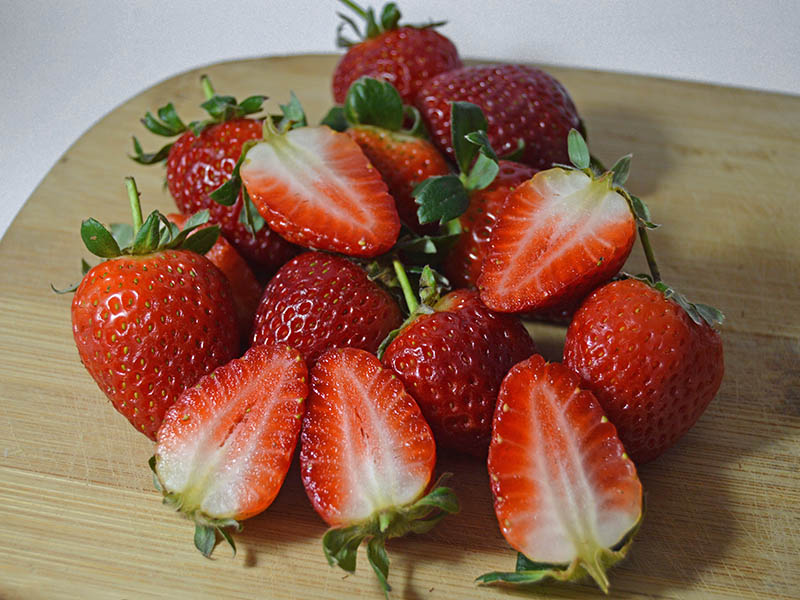
Strawberry or Fresas in Spanish is a common fruit in Spain and worldwide. Strawberry cultivation began to be popular in the 16th century, but the first strawberry garden appeared in the 18th century in France.
In Spain, it is also known as the “red gold”. Huelva region produces the most strawberries, with more than 90% of the country’s output. People will grow strawberries in a long plastic tunnel. Their season will last until late May or early June in Spain.
Strawberries have many types with numerous sizes, colors, shapes, and different flavors. In particular, there are about 200 tiny seeds in each strawberry. After washing, you can eat the whole strawberry.
Strawberries are good for health when they contain many vitamins and minerals. About 9 million tons of them were created in 2019, and China has the most strawberry production globally. You can eat strawberries with cream or make smoothies, salads, etc.
Nutrients: Rich in carbohydrates, protein, vitamin C, E, K, B, calcium, iron, magnesium, and phosphorus.
Season: It usually cultivates until the last week of May or the beginning week of June.
How to eat: You just need to rinse and use the whole strawberry.
8. Grape – Mencia

One of the famous Spanish drinks is grape wine, and Mencia or grape is a renowned grape in this country. It originated in the west of the Iberian Peninsula. It accounts for more than 9100 hectares of cultivated land in Spain.
It has a characteristic black color and mixed flavor of sourness and sweetness. Wine made from Mencia is usually pale and scented like red wines. Grape crops began to grow in Spain in the 1990s, leading to the development of the wine industry.
Twelve Grapes is a long tradition of Spanish. They will eat grapes with each of the twelve-clock bell strikes in the middle of the night on the last day of the year to welcome the new year. They think this will bring luck and prosperity in the New Year.
This tradition existed in 1895 and began to be popular in 1909. Typically, Spanish people will gather at home or in main squares.
Nutrients: Plenty of carbs, protein, negligible fat, and vitamin K.
Season: It lasts from September to October in Spain.
How to eat: You just need to wash the grapes and use a fork to enjoy them. You should remove seeds during consumption.
9. Watermelon – La Sandia

Watermelon is an excellent edible fruit of the Cucurbitaceae family. It is a kind of vine grown worldwide with about 1000 different variants. It is well-known in tropical climate regions, and it is a type of berry with thick and hard peel.
Its skin is usually green or black with vertical stripes. You will find gorgeous sweet and succulent flesh. Usually, it will be dark or pink with many tiny seeds. The Spaniards often eat raw or pickled.
In particular, the skin can be cooked into many different foods or made into salads. It is a perfect choice for smoothies, juice, and drinks. Seeds of watermelon appeared in the Dead Sea in ancient times. It was introduced in Spain in the 13th century by Moors.
In Spain, it is usually planted in greenhouses or farms. Murcia, Almeria, and Valencia are the most harvested areas in this country, making up 30% of the total output. In 2016, Spain produced about 969327 metric tons of watermelon.
Nutrients: It consists of vitamin C, A, B, potassium, magnesium, and phosphorus.
Season: The season of watermelon runs from May to October in Spain.
How to eat: You will cut the watermelon into slices and remove the skin before eating. Furthermore, you can use a spoon to get flesh after cutting watermelon into 2 halves.
10. Passion Fruit – La Parcha

Passion fruit is one of the most popular fruits in Spain. It is made up of passion flowers. It appeared in Europe for the first time in 1553. Its name has many different transcription versions, including “Passionfruit” or “Passion-fruit”.
Usually, it often has round or oval shapes with a diameter of about 1.5 to 3 inches. It has many different colors depending on each type, and yellow, red, purple, and green are the most popular colors.
There are about 4 main passion fruit types: purple passion fruit, yellow passion fruit, giant granadilla, and sweet granadilla. It contains many large seeds, and the Spanish will take advantage of its pulpy juice seeds to get juice.
Nutrients: Passion fruit is a source of carbs, fat, protein, calories, vitamin C, riboflavin, niacin, iron, and phosphorus.
Season: The summer season runs from July to October, and the winter season lasts from December to April in Spain.
How to eat: You can enjoy fruit pulp directly after cutting passion fruit into 2 parts. However, you should take a spoon to get the pulp and add a little sugar to create sweetness when eating as it is tart.
It is time to feel the real flavor of passion fruit by tasting it.
11. Ackee – Blighia

Ackee is a familiar fruit with Spaniards. It is native in West Africa and appears in various Ivory Coast foods and many other nations. It is a national fruit of Jamaica and is a delicacy of this cuisine.
Its shape is similar to a pear, and it is usually blue when unripe. Its color will gradually transfer to a yellow-orange shade when ripe. Soft, creamy, and spongy flesh will make you think of scrambled egg’s texture. It contains a lot of glossy black seeds.
Its season will extend from January to March and October to November. It has about 45 different types and is grouped into 2 main categories: cheese and butter. The butter will have dark yellow, while the cheese version will be pale yellow.
Nutrients: It is rich in carbs, protein, fat, fatty acids, palmitic, stearic acids, and vitamin C.
Season: It thrives strongly from January to March and October to November.
How to eat: You will remove its seeds and red lining. Wash flesh and wait for it to dry before using it for cooking.
12. Fig – Higo

When referring to delicious Spanish side dishes, it is impossible not to mention salads made from Higo (Fig) and cheese. This fruit is derived from the Mediterranean and Western Asia. And Higo cultivation has existed since ancient times.
It belongs to the Moraceae family with different types. Its shape is similar to tears. In particular, its green shell will turn purple or brown when ripe. You will be impressed with reddish flesh with numerous edible seeds.
In Spain, it is common in the Oregon region. Its sweetness and juiciness will not let you down. The crunchiness of the seeds is its highlight. The Spaniards often eat fresh Higo or dry it to preserve and enjoy later.
It thrives from the end of the summer to the beginning of autumn in the Northern Hemisphere. In Spain, its main season falls around August to October. You should try the jams processed from Higo when coming to Spain.
The Spaniards will harvest it in 2 seasons, including Breva and Higo. They will start with Breva. At this time, fig will have pale red meat and green skin. Moreover, it is bigger and sourer than Fig of Higo harvest.
Nutrients: Get a lot of carbohydrates, protein, fiber, calories, vitamin C, E, K, calcium, and other minerals after eating Higo.
Season: Its season begins in August and ends in October in Spain.
How to eat: Raw fid has the best flavor. You use a knife to remove its peel and enjoy the flesh. Also, you can bake or grill figs.
Most Popular Spanish Fruits Of Drupe Type
Drupe includes fruits with a large seed in the middle. In this section, I will introduce the outstanding fruits of Spain in the drupe group.
13. Mango – Mango
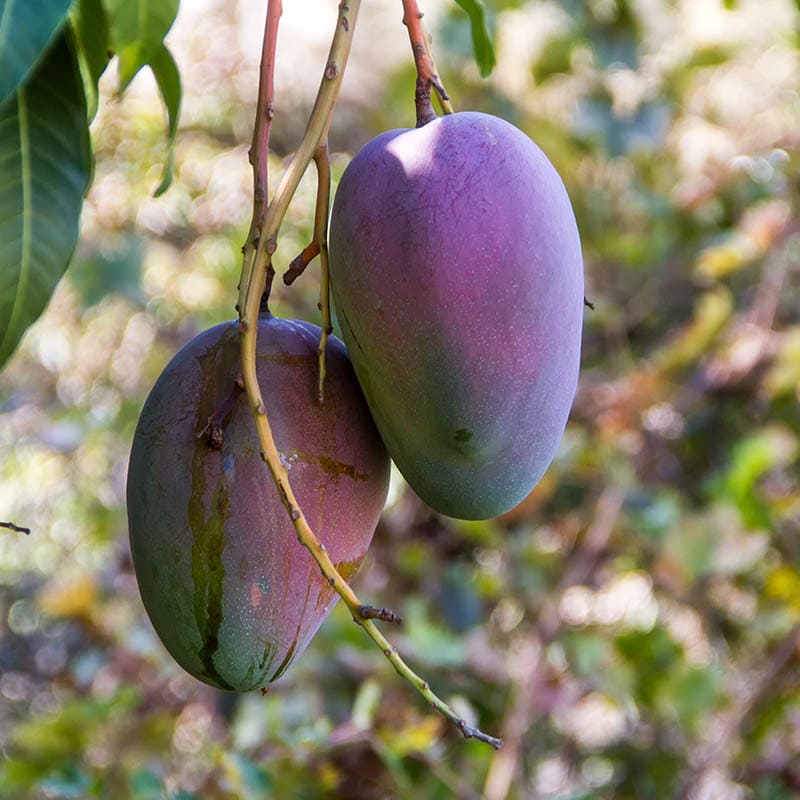
A mature mango tree is usually about 98 to 131 feet tall. There are hundreds of mango variants grown around the world. It has 3 parts, including thin skin, flesh, and an extensive seed in the middle. Usually, mango has blue skin when raw and will turn yellow or orange when ripe.
It has various shapes and sizes. It will have a light crispness and sweet-sour taste when enjoying raw mango. A ripe mango has yellow flesh and distinctive sweetness. Mango contains plenty of water, carbohydrates, and vitamin C.
This fascinating fruit has been derived from Southeast Asian countries since ancient times. In Spanish, the Malaga Costa tropical region of Granada is the most mango area. It mainly thrives from August to November.
Nutrients: Contain a lot of vitamin C, calories, protein, water, carbohydrates, and negligible fat.
Season: Common from August to November.
How to eat: You can eat raw or ripe. Cut into small pieces and use a toothpick to eat. You can consume its skin but do not eat the seed.
14. Cherry – Cerezas

If you want to enjoy cherries with the most fantastic flavor in Spain, you should go to northern Alicante and south of Valencia. They have grown popular in these two areas. The Romans brought cherries to Spain.
There are 2 main types of cherry, including sweet cherries and sour cherries. You can find different versions of cherries, such as True cherries, Bush cherries, Bird cherries, and Racemose cherries. They are native to Europe and West Asia.
Cherry season is usually short. It is generally ripe at the end of December in the Southern Hemisphere. You will love the cherries’ deep red shade, and its sweetness and tartness will fascinate you immediately.
If you have the opportunity to come to Spain in spring, you should attend Cherry Blossom Festival. This event has 3 different parts and will last until early May.
Nutrients: Sweet cherries have a lot of carbs, protein, fiber, vitamin C, and dietary minerals. Meanwhile, the sour version contains more vitamin C and A than the sweet version.
Season: It is common in Spain from April to August.
How to eat: The best moment to eat cherries is in the morning and after dinner. After washing, you can eat fresh cherries directly and remember to remove the seeds while consuming. You can make jams, salads, and desserts with cherries.
15. Peach – Melocoton

Peach has originated in Northwest China. It was introduced in Spain in the 12th century, and Spanish colonies brought it to the Americas in the 16th century. Gradually, peach cultivation takes place around the world.
When you arrive in Spain, you can enjoy Melocoton de Calanda. It is a famous peach in the eastern Autonomous Community in Aragon. It appeared in Aragon in the 19th century.
This type of peach is usually large with sweet flavor and juiciness. Normally, peach will have yellow and whitish flesh. Especially, its sophisticated aroma will passionate you. It contains a large seed that has a reddish-brown hue and oval shape.
There are many different types of peach. However, it was divided into two main categories: freestones and clingstones. Clingstones will have flesh clings stick to the pit, while flesh clings will separate from the pit in freestones type.
Nutrients: It is a rich source of water, carbs, fat, vitamin A, E, C, K, magnesium, iron, phosphorus, and zinc.
Season: Its season runs from late April to mid-October.
How to eat: Cut the peach into 2 halves and remove its seed. You can eat flesh and skin of it since its skin is safe and contains a lot of fiber. However, remember to rinse it before consuming.
Explore all things about delicious peaches immediately.
Do Not Miss 4 Excellent Spanish Citrus Fruits
There are countless types of citrus fruit in Spain. Here are the favorite citrus fruits in Spain you should not miss. Let’s check them out right away.
16. Orange – La Rananja
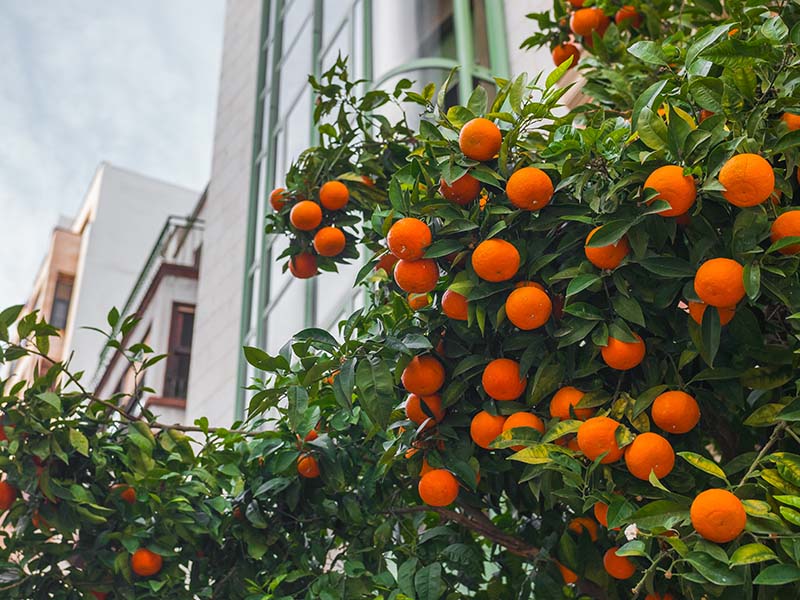
Orange is a common fruit around the world. It originated in the south of China, Myanmar, and Northeast India. It appeared in 314 BC and was widely grown worldwide in 1987. It appeared in Spain and European countries in the 10th century.
Initially, it was known as Al-Andalus. The Moors were the first to introduce it to the Iberian Peninsula. Valencia orange is a famous variant when its image is used as a mascot for the FIFA World Cup in 1982.
Typically, you can find about 9 seeds per orange. Occasionally, you will not be able to find seeds in oranges. It usually has a round or oval shape with thick skin.
Its flesh is composed of many citruses with plenty of water. You should be careful when walking in orange gardens since it can fall into your head.
It has various colors like green, orange, or yellow. It has a sweet, sour, or sour-sweet taste depending on different types of orange. You can feel a little bitter while eating it. The Spaniards often take the juice from it or make sauce from various foods.
Nutrients: The common nutrients of oranges are carbs, calories, vitamin C, E, B, calcium, iron, phosphorus, and other minerals.
Season: Spanish orange’s season extend from late December to mid-February.
How to eat: You can peel an orange by hand and separate each citrus to enjoy. Or, slice the orange into small slices vertically and eat directly from the peel.
17. Lime – Lima

Lime or Lima is an indispensable material in Spanish cuisine. It originated in Southeast Asia and South Asia and is associated with many Vietnamese recipes or Thailand, the Philippines, India, and many other countries in the area.
Nowadays, it has become popular all over the world. Mamoncillo is a famous lime in Spain. It is about 3 to 4 centimeters and is surrounded by thin, smooth, and tough skin. Its appearance looks pretty similar to Lychee.
Its flesh usually has a salmon-orange or pale yellow color. When tasting unripe Mamoncillo, its sour flavor will awaken you right away. Meanwhile, the ripe version will have gentle sourness and mix with sweetness.
This type often appears commonly in the summer months in Spain. The Spaniards often eat fresh Mamocillo and remove the skin and seeds. In addition, it is a fantastic component for making desserts and drinks.
Nutrients: It is a good source of vitamin A, C, phosphorus, fiber, and calcium.
Season: The season of lime usually falls in the summer months in Spain.
How to eat: You can lightly bite into its thin skin to peel easily. The best method to eat is to put whole fruit into the mouth and sucks the juice of pulp, and remove the seeds. You can roast seeds and eat chestnuts.
18. Kenepa Fruit (Guinep, Melicoccus, Limoncillo)

Kenepa or Melicoccus, Guinep, Limoncillo is a fruit of the Sapindaceae family. It has originated across South, Central America, and Caribbean countries. Apart from Spain, it is also an essential fruit in Haiti.
The description of it first appeared in 1756. Many ideas said it was planted for the first time in Puerto Rico. A private festival of this fruit (National Genip Fruit Festival) took place annually.
Its season often falls into the warm summer months. It usually appears with a round shape with a diameter of about 0.79 to 1.57 inches. Its skin is thin and has a distinctive green hue. It includes 1 or 2 whitish seeds.
An orange, gelatinous, and juice pulp will cover the seeds. It will have a bittersweet taste when ripe and is pretty similar to the flavor of the wine. The Spaniards will eat fresh or dried Kenepa.
Nutrients: You can find a lot of fiber, vitamins A, B, C, iron, amino acid tryptophan, and calcium from it.
Season: It is ripe in the summer months.
How to eat: You just need to peel by hand and enjoy its pulp. Remember to remove seeds.
Get these instructions to eat Guinep properly.
19. Custard Apple – Chirimoya
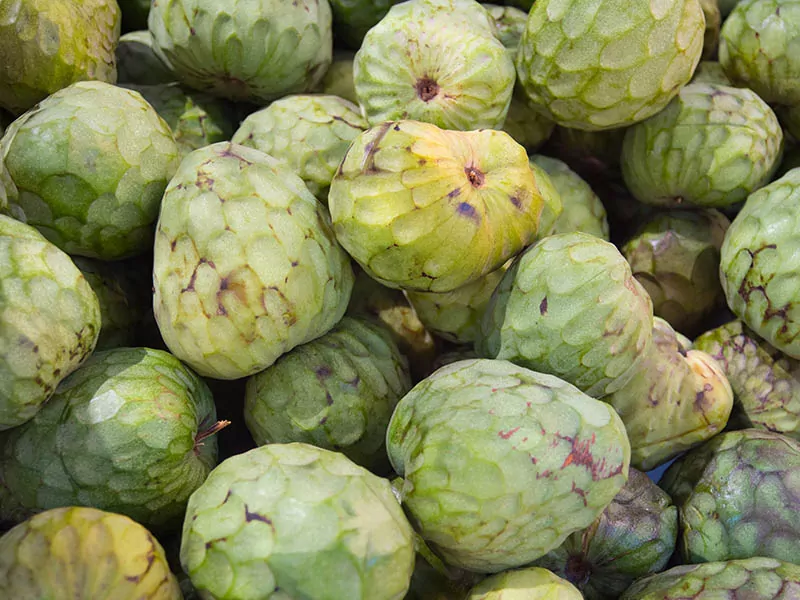
Fruit is one of the delicious Spanish desserts, and Chirimoya is one of them. It is also known as Cherimoya or Chirimoya. This name refers to Custard Apple. It is a fruit of the Annonaceae family with Sweetsop and Soursop.
It is natives in Ecuador, Peru, and many other South American countries, and significantly it is grown commonly in the Andes and Central America. It is pretty well-known in Spain, especially in the south of Granada. You can also see it in Asia, Africa, and the Mediterranean.
Usually, Chirimoya has green skin and a heart shape. When ripe, it will gradually turn to brown with a fissured surface. Inside, it has countless edible and black seeds with about 0.39 to 0.79 inches. Its flesh has a creamy texture and opaque shade.
Its taste is a combination of bananas, pineapple, strawberry, and kiwi. You will feel the sour and sweet flavor blended when consuming it. Its texture is pretty similar to pudding, so it has the English name “Custard Apple”.
Its name originated from the word “chirimuya,” which means “cold seeds”. Cold weather is a favorable condition for its development.
Nutrients: Plenty of water, carbohydrate, protein, fat, vitamin B6, C, and fiber.
Season: Normally from September to January. October and November are the best months for its development, and people usually harvest it until April.
How to eat: Cut fruit into 2 parts, and use a spoon to get the flesh out of the skin. When eating, you should remove the seeds. You can use it to make ice cream, puddings, mousse, and pie fillings.
What Are Common Spanish Fruits That Classify In Pome Category?
If you like the fruits of the pome category, you should not ignore this part. They are incredible options that you can try when coming to Spain.
20. Loquat – Nispero Fruit

Loquat or Nispero Fruit is pretty standard in Spain when this country produces the most Loquat in the world. It originates in cooler hills in southern China, and it has also existed in Japan for over 1000 years. It appeared in Europe in the 16th century.
Loquat is usually ripe in early spring and summer. It appears in oval, round, or pear-like shapes. You will feel comfortable touching its smooth yellow or red-flushed skin. It is time to fall in love with the tangy taste and juiciness of its white, yellow, or orange flesh.
You can find about 1 to 10 ovules in each Loquat, and they will be grown into seeds. The Spaniards often eat fresh Loquat or combine it in salads or fruit cups. In addition, it is suitable for processing jam, jelly, and smoothies.
Argelino and Tanaka are the 2 main types of Loquat in Spain. If you want to consume fresh, you should choose Argelino because it is soft and sweeter. Meanwhile, Tanaka version will be suitable for cooking.
Nutrients: It is high in vitamin A, vitamin B6, fiber, potassium, manganese, and other minerals.
Season: It thrives during April, May, and June.
How to eat: You can peel its skin and consume around the seeds or cut into 2 parts, remove its seeds and eat around the skin.
Listen to essential things about the appearance and flavor of Loquat.
21. Quince – Membrillo

Quince or Membrillo is a fruit that appears in many Spanish foods and European recipes. It belongs to the Rosaceae family with pears and apples. Therefore, its appearance looks pretty similar to pear with a prominent golden-yellow shade.
This fruit is native to the southern Hyrcanian region of the Caspian Sea. It can grow well in many different weather conditions. However, to be suitable for its development, 45 degrees F is the ideal temperature.
Raw Quince usually appears with a green leather thin skin and a thick gray-white hair layer. When it is ripe, this layer will disappear, and the skin will turn yellow. Usually, it will start to mature at the end of autumn. Its flesh is pretty hard and has intense perfume.
When eating this fruit, you will be conquered by the sour and astringent flavor. Usually, Spaniards often cook it to make jams and desserts to reduce hardness. In particular, its seeds contain nitriles and will harm your health when consuming too much.
Nutrients: It is a source of water, protein, carbs, and vitamin C.
Season: Its season begins in September and ends in November in Spain.
How to eat: To eat Quince, you need to peel the skin and eat its flesh. It is suitable for adding to pastries, combining with apples in crumbles, and roasting with cinnamon.
22. Apple – Manzana

Manzana or apple is a fruit planted around the world. Apple tree originates from Central Asia. Apples have appeared in Europe and Spain for several thousand years. Spanish and European colonists have introduced it to North America.
Bierzo district of Leon Province is a famous planted-apple area in Spain. You will feel the charming aroma of Spanish apples. The succulent and crispness of apples will conquer you immediately.
Manzana usually has dark green skin and a few brown spots. Its flesh will have yellowish-white color, yellow, pink, or green. Most apples are a blend of a bit of sweetness and a little sour taste.
Nutrients: Apples contain a vast source of carbs, fat, protein, calories, fiber, vitamins, and minerals.
Season: Apples are ripe at the end of summer or autumn in Spain.
How to eat: To eat apples hygienically, you will peel the whole apple skin and cut the apple into bite-size pieces. In particular, remember to remove the seeds in the middle.
23. Pear – Pera

When it comes to famous Spanish fruits, it is impossible not to mention pear. It is a global fruit when planted and consumed worldwide. It is native to coastal Europe, North Africa, and Asia. There are about 3000 types of pear worldwide.
Pyrus Bourgaeana is a famous pear in the Iberian Peninsula. It existed about 2500 years ago. Llano de Lleida of Lleida province is the prominent place for producing pear in Spain.
The pears often have a bright yellow shade and white flesh. You will be impressed with the sweet taste and the juiciness of the pear. Especially, its charming and gentle aroma will wake you up instantly.
The sugar and acid content of the pear is in an appropriate state. Pear cultivation and harvesting depend on different geographical regions. The pear season in Spain usually starts in September and ends in February.
Nutrients: Carbs, protein, fat, fiber, vitamins C, E, K, and minerals are essential nutrients in pear.
Season: Its season extends from September to February in Spain.
How to eat: Before enjoying a pear, you just need to peel its skin and slice it into small pieces. Remove the seeds of the pear to ensure safety.
Share Your Thoughts!
Nowadays, fruits have become an essential part of everyone’s daily meal thanks to their high nutrient content. In addition, fruits bring a fresh and pleasant feeling when enjoyed, so save this list right now to taste when coming to Spain.
Do you know any other famous Spanish fruits? If yes, do not hesitate to share in the comment section. In particular, please introduce this fantastic article to many others. Thanks for reading!








A city to enjoy its beaches and leisure, without forgetting the Alicante rice.